The demand for gluten-free prepared food in Japan is projected to grow from USD 325.3 million in 2025 to USD 490.9 million by 2035, reflecting a CAGR of 4.2%. The increasing awareness of gluten intolerance, celiac disease, and the rising demand for health-conscious eating are driving the demand for gluten-free food options. As consumer health and wellness trends continue to dominate the food industry, Japan's growing interest in functional foods and specialty diets will sustain the demand for gluten-free prepared foods. Additionally, the rise of food personalization and clean-label products is propelling manufacturers to offer more gluten-free alternatives across snack foods, ready-to-eat meals, and bakery products.
The gluten-free food market in Japan will also benefit from innovations in ingredients and formulation technologies to improve the taste, texture, and nutritional value of gluten-free products. As more consumers adopt gluten-free diets for health reasons and lifestyle preferences, food manufacturers will continue to expand their gluten-free offerings. Furthermore, foodservice providers and grocery chains are increasingly catering to special dietary needs, making gluten-free prepared food more accessible to the Japanese population. This trend will be reinforced by rising consumer awareness and regulatory frameworks supporting dietary inclusivity and nutritional transparency.
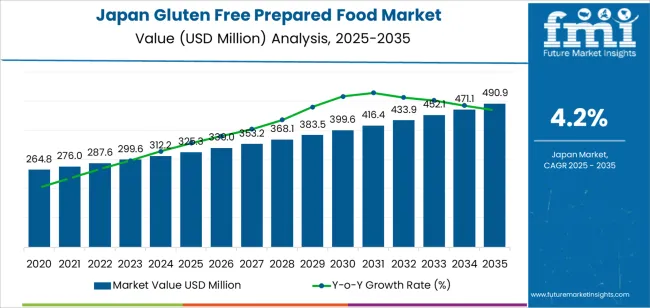
The growth contribution index for gluten-free prepared food in Japan reflects the significant value added during each phase of the market's expansion, identifying the periods that will have the greatest impact on overall market growth.
From 2025 to 2030, the market will grow from USD 325.3 million to USD 399.6 million, adding USD 74.3 million in value. This phase is expected to account for a strong contribution to overall growth, driven by rising consumer awareness about gluten-related health issues and the expanding availability of gluten-free products in retail and foodservice sectors. The market will see rapid adoption during this period, as health-conscious consumers increasingly seek out gluten-free options for better digestion, weight management, and overall wellness. This period will be marked by significant growth in product offerings, with brands focusing on innovative and affordable gluten-free solutions that cater to the growing demand.
From 2030 to 2035, the market will grow from USD 399.6 million to USD 490.9 million, contributing USD 91.3 million in value. While growth continues, this phase will experience a slower acceleration compared to the first half of the forecast period, as the market reaches a more mature stage. The demand will still rise steadily, driven by the continued focus on health and wellness, but the growth rate will moderate as market saturation increases and gluten-free options become more widely available. The growth contribution in this phase will still be substantial but will reflect a more incremental adoption as consumer demand stabilizes and product innovation moves towards optimization rather than new market entry. Despite the slowdown, the market will continue to benefit from ongoing consumer interest in specialty diets and personalized nutrition, ensuring a consistent demand for gluten-free prepared food throughout the forecast period.
| Metric | Value |
|---|---|
| Industry Sales Value (2025) | USD 325.3 million |
| Industry Forecast Value (2035) | USD 490.9 million |
| Industry Forecast CAGR (2025 to 2035) | 4.2% |
Demand for gluten free prepared food in Japan is growing as health conscious consumers and allergen aware individuals increasingly seek convenient meal solutions that avoid wheat, barley and rye. The expanding awareness of gluten related sensitivities and the broader wellness trend fuel interest in gluten free ready meals, snack items and bakery products. According to industry sources, the Japanese gluten free food and beverages market is projected to grow at a CAGR of around 6.4% between 2025 and 2033.
Another key driver is the evolution of distribution channels and foodservice formats that facilitate greater access to gluten free prepared foods. Retailers, convenience stores and online platforms are offering increased choices in gluten free meals, snacks and bakery items, enabling consumers to integrate these products into everyday or on the go consumption. Additionally, the development of alternative flours and processing technologies designed to replicate texture and taste encourages broader adoption beyond strictly medical need. That said, challenges remain, including higher cost of gluten free ingredients, limited product variety compared to conventional foods, and regulatory ambiguities around labeling standards. Even so, given the alignment of convenience, wellness demand and improved product availability, the demand for gluten free prepared food in Japan is expected to advance steadily.
The demand for gluten-free prepared food in Japan is primarily driven by product type and sales channel. The leading product type is drinks, capturing 45% of the market share, while supermarkets are the dominant sales channel, accounting for 55% of the demand. Gluten-free prepared foods are becoming increasingly popular among health-conscious consumers and those with gluten sensitivities or celiac disease. The demand for these products is growing as more consumers seek convenient and dietary-specific food options.

Drinks lead the gluten-free prepared food market in Japan, accounting for 45% of the demand. Gluten-free beverages, including fruit juices, smoothies, dairy-free alternatives, and gluten-free soft drinks, are gaining traction as consumers increasingly prioritize health-conscious beverage options. These drinks cater to individuals with dietary restrictions or preferences for gluten-free alternatives, making them an attractive choice in a health-focused food market.
The growing demand for gluten-free drinks is driven by factors such as the rise in gluten sensitivities, the increasing popularity of plant-based diets, and the demand for more natural and allergen-free products. Additionally, the beverage industry in Japan has seen a shift toward functional drinks that offer added health benefits, such as probiotics, vitamins, or low-sugar formulations. As awareness of gluten-related health issues continues to rise, gluten-free drinks are expected to remain a dominant and growing segment in Japan's gluten-free food market.
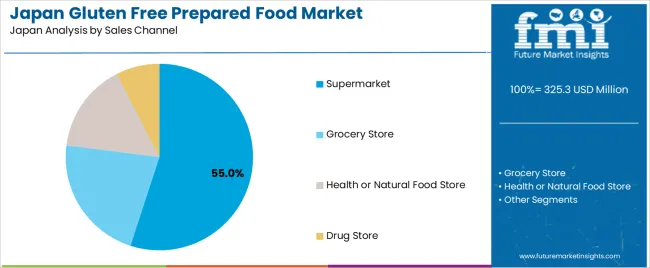
Supermarkets are the leading sales channel for gluten-free prepared food in Japan, capturing 55% of the demand. Supermarkets are well-positioned to meet the increasing consumer demand for gluten-free products due to their wide reach and convenience. They offer a broad selection of gluten-free food items, ranging from ready-to-eat meals and snacks to specialized beverages and bakery products. The availability of gluten-free foods in mainstream supermarkets ensures that consumers have easy access to these products.
The dominance of supermarkets is driven by their ability to provide a one-stop shopping experience, where consumers can find gluten-free products alongside traditional food options. Additionally, the growing consumer preference for gluten-free diets, combined with the expansion of dedicated gluten-free sections in many supermarkets, has further propelled this trend. As the trend toward healthier, more inclusive food choices continues, supermarkets will remain the primary channel for distributing gluten-free prepared food in Japan.
What Are the Key Dynamics Influencing Demand for Gluten Free Prepared Food in Japan? Demand for gluten free prepared food in Japan is gaining momentum as wellness focused consumers and those with gluten related sensitivities seek safer, cleaner label meal solutions. The food manufacturing industry is responding with bakery items, snacks and ready to eat meals that substitute wheat with rice or alternative flour. The category’s growth is influenced by urbanisation, convenience eating trends and rising health awareness across age groups. However, the market remains comparatively nascent in Japan due to limited standardisation of gluten free labelling and strong cultural preference for wheat based foods.
What Are the Primary Growth Drivers for Gluten Free Prepared Food Demand in Japan? Several factors support demand expansion. First, growing consumer interest in digestive health, food allergies and wellness diets leads more individuals to seek gluten free formats. Second, manufacturers are introducing rice flour breads, snacks, pasta and sweets to cater to this niche yet growing segment. Third, convenience store chains and online food retail platforms increase availability of gluten free prepared meals, tapping into Japan’s busy lifestyles. Fourth, the clean label movement encourages food brands to highlight allergen reduced and wheat free credentials, creating marketing incentive for gluten free prepared food launches.
What Are the Key Restraints Affecting Gluten Free Prepared Food Demand in Japan? Despite favourable trends, several restraints exist. The prevalence of celiac disease and diagnosed gluten intolerance in Japan is lower than in Western markets, limiting the medically mandatory consumer base and slowing scale up of gluten free prepared food. Additionally, absence of legally unified “gluten free” labelling standards and common use of wheat based seasonings create consumer uncertainty. Cost premiums for alternative flour based production and limited cost effective supply chains constrain competitive pricing. Finally, entrenched cultural preference for wheat based staples such as ramen and udon limit substitution of traditional meals by gluten free variants.
What Are the Key Trends Shaping Gluten Free Prepared Food Demand in Japan? Emerging trends include increased innovation in ready to eat and frozen gluten free meal kits, snacks and desserts tailored to Japanese flavors and ingredients. The shift toward plant based and flexitarian diets supports gluten free variants that also emphasise sustainability and wellness. Online only brand launches and direct to consumer subscription formats are gaining traction as access expands beyond conventional retail. Also, food service and restaurant chains are offering dedicated gluten free menus, raising category awareness and boosting demand for prepared food items that crossover into retail.
The demand for gluten-free prepared food in Japan is driven by a combination of growing awareness of gluten sensitivities, health trends, and the increasing popularity of gluten-free diets, even among individuals who do not have celiac disease. As more consumers seek to improve their overall health and well-being, gluten-free options have become more mainstream, not just for people with gluten intolerance, but also for those adopting gluten-free lifestyles for general health reasons. Additionally, the rise in demand for specialty diets, including gluten-free, has been fueled by increased availability of gluten-free products in supermarkets, restaurants, and convenience stores.
The growing emphasis on healthy eating, clean-label products, and awareness of food allergies has led to greater acceptance of gluten-free food in the Japanese market. Regional variations in demand reflect consumer preferences, local food trends, and the availability of gluten-free options across Japan’s diverse regions. Below is an analysis of the demand for gluten-free prepared food across different regions in Japan.
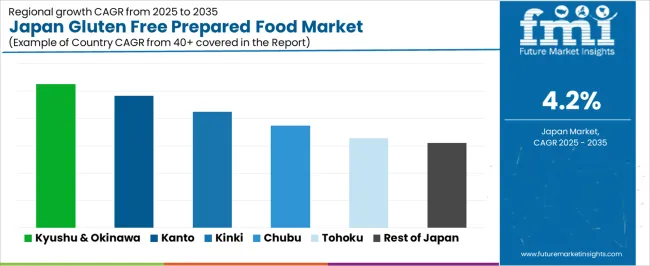
| Region | CAGR (2025-2035) |
|---|---|
| Kyushu & Okinawa | 5.3% |
| Kanto | 4.8% |
| Kinki | 4.2% |
| Chubu | 3.7% |
| Tohoku | 3.3% |
| Rest of Japan | 3.1% |
Kyushu & Okinawa leads the demand for gluten-free prepared food in Japan with a CAGR of 5.3%. The region's higher adoption of health-conscious eating habits, particularly in Okinawa, which is famous for its long-lived population and healthy diet, has fostered greater demand for gluten-free options. The emphasis on natural, fresh, and whole foods in Okinawa has led to the popularization of gluten-free diets for both health and wellness.
Kyushu & Okinawa's progressive food culture, coupled with rising awareness of food allergies and sensitivities, has contributed to increased availability of gluten-free prepared food products in both supermarkets and restaurants. Additionally, the rise of specialized health food stores and the increased focus on organic and clean-label foods in this region has further supported the demand for gluten-free options.

Kanto shows strong demand for gluten-free prepared food with a CAGR of 4.8%. Kanto, which includes Tokyo and its surrounding areas, is a major urban and economic hub, with a large population that is increasingly health-conscious. The region’s high number of health-conscious consumers, along with a growing interest in special diets like gluten-free, has driven the demand for gluten-free prepared foods. As more individuals seek convenient, nutritious, and gluten-free options, restaurants, grocery stores, and supermarkets in Kanto are expanding their gluten-free offerings.
Additionally, Kanto’s influence on food trends, coupled with a wide availability of gluten-free packaged products, has further boosted the region’s demand for gluten-free prepared food. The rising number of food service businesses catering to gluten-free diets and growing awareness of food intolerances in urban areas is contributing to the sustained growth in this market.
Kinki, with a CAGR of 4.2%, shows steady demand for gluten-free prepared food. The region, which includes Osaka, Kyoto, and Kobe, has a strong food culture and a growing awareness of dietary preferences and sensitivities, including gluten intolerance. Kinki’s foodservice and retail industries have increasingly adopted gluten-free products, particularly in response to consumer demand for healthier alternatives and more inclusive food options.
While the growth rate in Kinki is slightly slower than in Kyushu & Okinawa and Kanto, the region's continued focus on food safety, nutritional quality, and clean-label products is driving the steady growth of the gluten-free market. As consumers in Kinki continue to seek healthier and more specialized food options, the demand for gluten-free prepared food is expected to remain strong.
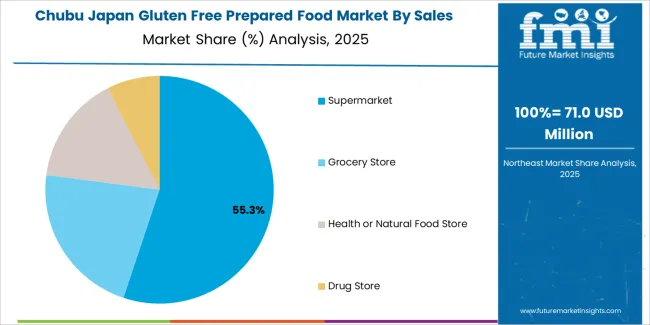
Chubu shows moderate growth in the demand for gluten-free prepared food with a CAGR of 3.7%. The region, which includes Nagoya, is known for its manufacturing base, but it is also seeing an increase in consumer interest in health and wellness. While Chubu's demand for gluten-free prepared foods is not as high as in other regions, the growing awareness of gluten sensitivities and the rise in healthy eating trends are contributing to a steady increase in market demand.
The demand for gluten-free products in Chubu is supported by the region’s expanding health food sector, increasing availability of gluten-free options in supermarkets, and the growing trend of clean-label and natural foods. As consumers in Chubu become more health-conscious, the demand for gluten-free prepared food is expected to continue growing at a moderate pace.
Tohoku, with a CAGR of 3.3%, and the Rest of Japan, with a CAGR of 3.1%, show slower growth in the demand for gluten-free prepared food compared to other regions. These regions are more rural and less densely populated, and consumer interest in specialized diets like gluten-free may be slower to take root compared to urbanized areas. However, there is a growing recognition of food allergies and sensitivities, and as awareness of gluten-free diets increases, the demand for gluten-free prepared food is gradually rising in these regions.
As the trend toward healthy, specialized diets spreads across Japan, and as more retailers and food service providers offer gluten-free products, the demand in Tohoku and the Rest of Japan is expected to grow, but at a more moderate pace than in other regions. The increasing availability of gluten-free products in local supermarkets and food establishments will help support gradual growth in these areas.
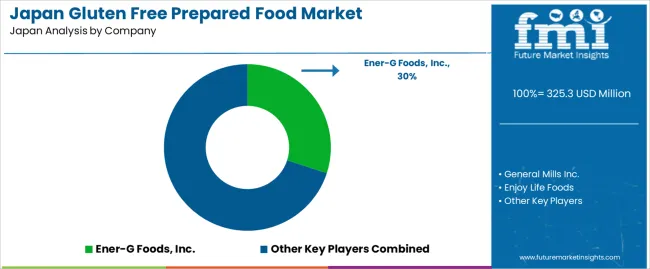
The demand for gluten-free prepared food in Japan is growing, driven by increasing awareness of gluten sensitivities, celiac disease, and the broader trend toward health-conscious eating. Companies like Ener-G Foods, Inc. (holding approximately 30% market share), General Mills Inc., Enjoy Life Foods, Udi's Healthy Foods, LLC, and B&G Foods, Inc. are key players in this market. The gluten-free food market in Japan is expanding as more consumers seek convenient, ready-to-eat products that align with their dietary preferences or medical requirements.
Competition in the gluten-free prepared food industry is primarily driven by taste, product variety, and nutritional value. Companies are focusing on improving the flavor and texture of gluten-free products to cater to both gluten-sensitive consumers and those without dietary restrictions. Additionally, there is an increasing demand for clean-label and natural ingredients, with consumers preferring gluten-free foods made with minimal processing and without artificial additives. Another area of competition is innovation in packaging and convenience, as businesses seek to offer easy-to-carry, single-serve products that cater to Japan’s fast-paced lifestyle. Marketing materials often highlight product taste, nutritional benefits, and the use of high-quality, natural ingredients. By aligning their offerings with the growing consumer demand for gluten-free, healthy, and convenient food options, these companies aim to strengthen their position in the Japanese gluten-free prepared food market.
| Items | Details |
|---|---|
| Quantitative Units | USD Million |
| Regions Covered | Japan |
| Product Type | Drinks, Bakery Products, Ready to Eat Products, Bread and Rolls, Pasta |
| Sales Channel | Supermarket, Grocery Store, Health or Natural Food Store, Drug Store |
| Key Companies Profiled | Ener-G Foods, Inc., General Mills Inc., Enjoy Life Foods, Udi's Healthy Foods, LLC, B&G Foods, Inc. |
| Additional Attributes | The market analysis includes dollar sales by product type and sales channel categories. It also covers regional demand trends in Japan, driven by the increasing adoption of gluten-free diets. The competitive landscape highlights major players focusing on innovations in gluten-free prepared foods, with a focus on health-conscious consumers. Trends in the growing demand for gluten-free drinks, bakery products, and ready-to-eat meals are explored, along with advancements in product quality, packaging, and distribution strategies. |
The demand for gluten free prepared food in Japan is estimated to be valued at USD 325.3 million in 2025.
The market size for the gluten free prepared food in Japan is projected to reach USD 490.9 million by 2035.
The demand for gluten free prepared food in Japan is expected to grow at a 4.2% CAGR between 2025 and 2035.
The key product types in gluten free prepared food in Japan are drinks, bakery products, ready to eat products, bread and rolls and pasta.
In terms of sales channel, supermarket segment is expected to command 55.0% share in the gluten free prepared food in Japan in 2025.






Our Research Products

The "Full Research Suite" delivers actionable market intel, deep dives on markets or technologies, so clients act faster, cut risk, and unlock growth.

The Leaderboard benchmarks and ranks top vendors, classifying them as Established Leaders, Leading Challengers, or Disruptors & Challengers.

Locates where complements amplify value and substitutes erode it, forecasting net impact by horizon

We deliver granular, decision-grade intel: market sizing, 5-year forecasts, pricing, adoption, usage, revenue, and operational KPIs—plus competitor tracking, regulation, and value chains—across 60 countries broadly.

Spot the shifts before they hit your P&L. We track inflection points, adoption curves, pricing moves, and ecosystem plays to show where demand is heading, why it is changing, and what to do next across high-growth markets and disruptive tech

Real-time reads of user behavior. We track shifting priorities, perceptions of today’s and next-gen services, and provider experience, then pace how fast tech moves from trial to adoption, blending buyer, consumer, and channel inputs with social signals (#WhySwitch, #UX).

Partner with our analyst team to build a custom report designed around your business priorities. From analysing market trends to assessing competitors or crafting bespoke datasets, we tailor insights to your needs.
Supplier Intelligence
Discovery & Profiling
Capacity & Footprint
Performance & Risk
Compliance & Governance
Commercial Readiness
Who Supplies Whom
Scorecards & Shortlists
Playbooks & Docs
Category Intelligence
Definition & Scope
Demand & Use Cases
Cost Drivers
Market Structure
Supply Chain Map
Trade & Policy
Operating Norms
Deliverables
Buyer Intelligence
Account Basics
Spend & Scope
Procurement Model
Vendor Requirements
Terms & Policies
Entry Strategy
Pain Points & Triggers
Outputs
Pricing Analysis
Benchmarks
Trends
Should-Cost
Indexation
Landed Cost
Commercial Terms
Deliverables
Brand Analysis
Positioning & Value Prop
Share & Presence
Customer Evidence
Go-to-Market
Digital & Reputation
Compliance & Trust
KPIs & Gaps
Outputs
Full Research Suite comprises of:
Market outlook & trends analysis
Interviews & case studies
Strategic recommendations
Vendor profiles & capabilities analysis
5-year forecasts
8 regions and 60+ country-level data splits
Market segment data splits
12 months of continuous data updates
DELIVERED AS:
PDF EXCEL ONLINE
Demand Signal Repository Solutions Market Size and Share Forecast Outlook 2025 to 2035
Demand Side Management Market Size and Share Forecast Outlook 2025 to 2035
Demand Response Market Analysis - Size, Share, and Forecast Outlook 2025 to 2035
North America Shipping Supplies Market Trends – Innovations & Growth 2024-2034
Demand of Kozani Saffron in Greece Analysis - Size, Share & Forecast 2025 to 2035
Demand of No-acid Whey Strained Dairy Processing Concepts in European Union Size and Share Forecast Outlook 2025 to 2035
Demand for Bronte Pistachio in Italy Analysis - Size, Share & Forecast 2025 to 2035
Demand and Trend Analysis of Gaming Monitor in Western Europe Size and Share Forecast Outlook 2025 to 2035
Demand and Trend Analysis of Gaming Monitor in Korea Size and Share Forecast Outlook 2025 to 2035
Demand and Trend Analysis of Gaming Monitor in Japan Size and Share Forecast Outlook 2025 to 2035
Glycine Soja (Soybean) Seed Extract Market Size and Share Forecast Outlook 2025 to 2035
Demand and Trend Analysis of Yeast in Japan - Size, Share, and Forecast Outlook 2025 to 2035
Demand of Pistachio-based desserts & ingredients in France Analysis - Size, Share & Forecast 2025 to 2035
Western Europe Men’s Skincare Market Analysis – Forecast 2023-2033
Demand and Trends Analysis of Stevia in Japan Size and Share Forecast Outlook 2025 to 2035
Japan Women’s Intimate Care Market Trends – Growth & Forecast 2024-2034
Demand and Trend Analysis of Fabric Stain Remover in Korea Size and Share Forecast Outlook 2025 to 2035
Demand and Sales Analysis of Paper Cup in Korea Size and Share Forecast Outlook 2025 to 2035
Demand and Sales Analysis of Paper Cup in Western Europe Size and Share Forecast Outlook 2025 to 2035
Demand of MFGM-enriched Powders & RTDs in European Union Size and Share Forecast Outlook 2025 to 2035

Thank you!
You will receive an email from our Business Development Manager. Please be sure to check your SPAM/JUNK folder too.
Chat With
MaRIA